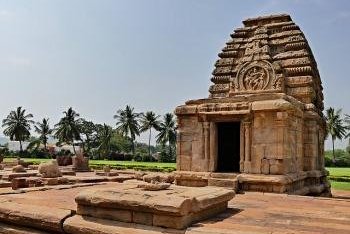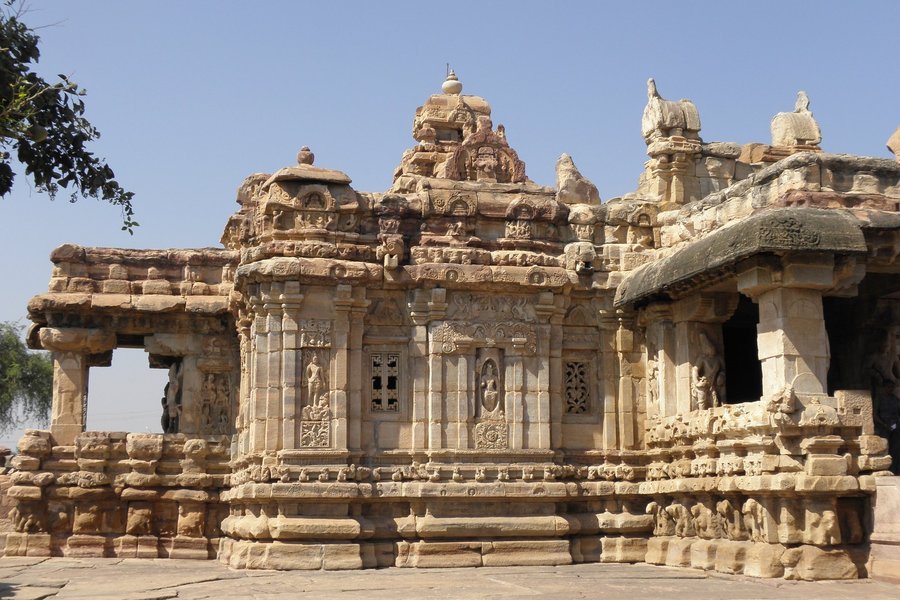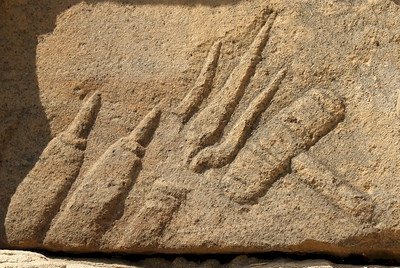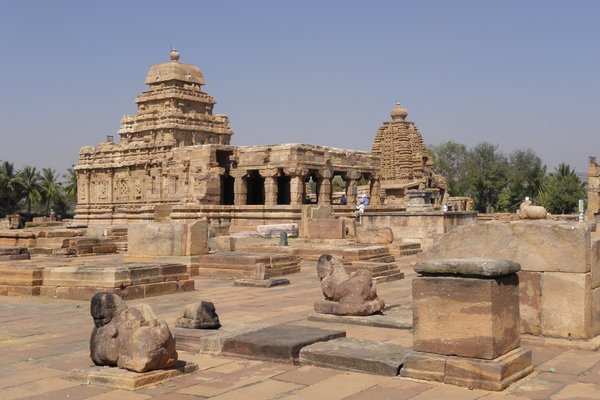India
Pattadakal
The Group of Monuments at Pattadakal are temples and architectural models that show both Dravidian (South Indian) and Indo-Aryan (North Indian) styles of architecture, and a unique blend of these two.
They were commissioned by the Chalukya Dynasty who ruled part of South India, and Pattadakal was their ceremonial capital. The constructions mainly date from the 7th and 8th centuries. They include 9 Shiva Temples and 1 Jain Temple. Part of the site is still in use as an active centre of worship, mainly at the sacred bull Nandi which is made of black granite and fully intact.
Community Perspective: This is a fairly remote site and it is best to hire a car+driver from Hospet/Hampi for a day to get there. Overall, “a very interesting WHS but an extension with Aihole and Badami will really boost this site's OUV”.
Site Info
Official Information
- Full Name
- Group of Monuments at Pattadakal (ID: 239)
- Country
- India
- Status
-
Inscribed 1987
Site history
History of Pattadakal
- 1987: Inscribed
- Inscribed
- Type
- Cultural
- Criteria
- iii
- iv
Links
- UNESCO
- whc.unesco.org
- Official
-
- asi.nic.in — Archaeological Survey of India
All Links
UNESCO.org
- whc.unesco.org — whc.unesco.org/
Official Website
- asi.nic.in — Archaeological Survey of India
News Article
- Aug. 11, 2019 google.com — Pattadakal inundated in Karnataka floods
- Nov. 14, 2014 sciencedaily.com — Art historian cracks the code of Virupaksha Temple
- Oct. 25, 2014 deccanchronicle.com — Pattadakal official guides leaving because of lack of income
Community Information
- Community Category
- Religious structure: Hindu
- Archaeological site: South (East) Asian
Travel Information
Recent Connections
-
Perfect Inscriptions
1987 -
Shiva cult
"Pattadakal possesses a sort of holy ci… -
Foreigner prices
Citizens of India and visitors of SAARC…
Connections of Pattadakal
- History
-
-
Located in a Former Capital
Chalukya Kingdom (c. 543-757)
-
- Architecture
-
-
Dravidian Architecture
temples of a pure Dravidian style - Sangameshvara, built between 696 and 733, and Mallikarjuna, built consecutively from 733-44 (AB ev)
-
- World Heritage Process
-
-
Perfect Inscriptions
1987 -
Extensions on Tentative List
Evolution of Temple Architecture - Aihole-Badami- Pattadakal
-
- Religion and Belief
-
-
Hindu pilgrimage sites
major pilgrim center for karnataka state -
Jainism
Jain temple -
Shiva cult
"Pattadakal possesses a sort of holy city comprised of an impressive series of eight Hindu temples dedicated to Siva. Somewhat off to the side, towards the village, is the ninth Sivaite sanctuary, the Temple of Papanatha," (AB ev)
-
- Human Activity
-
-
Erotic art
There are Erotic Sculptures on the wooden car (chariot) in Pattadakal.See www.kamat.com
-
- Timeline
-
-
Built in the 8th century
Masterpiece Temple of Virupaksha, built c. 740
-
- Visiting conditions
-
-
Foreigner prices
Citizens of India and visitors of SAARC (Bangladesh, Nepal, Bhutan, Sri Lanka, Pakistan, Maldives and Afghanistan) and BIMSTEC Countries (Bangladesh, Nepal, Bhutan, Sri Lanka, Thailand and Myanmar) - Rs.30 per head. Others: Rs. 500/- per headSee asi.nic.in
-
News
- google.com 08/11/2019
- Pattadakal inundated in Karnataka …
- sciencedaily.com 11/14/2014
- Art historian cracks the code of V…
- deccanchronicle.com 10/25/2014
- Pattadakal official guides leaving…
Recent Visitors
Visitors of Pattadakal
- Alexander Lehmann
- A. Mehmet Haksever
- Artur Anuszewski
- Atila Ege
- Bernard Joseph Esposo Guerrero
- Cheryl
- Clyde
- Dimitar Krastev
- Dylan
- Els Slots
- emvcaest
- Erik Jelinek
- Grzegorz Andruszkiewicz
- Iain Jackson
- Ivan Rucek
- Knut
- Kurt Lauer
- Lukasz Palczewski
- Luke LOU
- Mahuhe
- Martin
- Martina Rúčková
- Michael Ayers
- Mikko
- Milan Jirasek
- Miloš Tašković
- Mkandasa
- MMM
- Nihal Ege
- Paul Schofield
- Philipp Leu
- Philipp Peterer
- Randi Thomsen
- Roman Bruehwiler
- Sergio Arjona
- Solivagant
- Stanislaw Warwas
- Stijn
- Svein Elias
- Szucs Tamas
- Thomas Buechler
- Thomas van der Walt
- Vanessa Buechler
- Westwards
- Wojciech Fedoruk
- Zoë Sheng
Community Reviews
Show full reviews
I visited this WHS in November 2016. It is a great mix of Dravidian and Rekha-nagara styles but in terms of size it is more comparible to Khajuraho than Hampi.
I really enjoyed the main temple complex of Pattadakal consisting of Galganatha, Sangamesvara, Virupaksha and Kashi Vishweshvara temples as well as several remains and minor shrines. Near the main complex lies the beautifully sculpted Papanatha Temple with a raised podium and superb Ramayana sculptures on the Southern wall (best to visit in the afternoon for photography).
About 3km away is the Jaina Narayan Temple which has recently been completely dismantled, numbered and painstakingly rebuilt stone by stone. Due to recent floods, the walls have become darker and the humid and dark interior has attracted several bats.
All in all Pattadakal is a very interesting WHS but an extension with Aihole and Badami will really boost this site's OUV in my opinion.
Keep reading 0 comments
There is a place in Karnataka which, however iscribed as UNESCO Patrimony of Mankind, is very rarely visited by foreign tourists. These are magnificent temples in Pattadakal, nearby temples in Aihole and ancient caves in Badami (the latter two on TWHS so far). The reason of these rare visits is location – Pattadakal is distant from big cities and railway lines. The most convenient way to reach Pattadakal is taking a taxi from Hampi. Full day trip in March 2015 cost me 3300 rupees (I travelled alone).
I started my trip from Aihole, well-known place of cult, but in rather poor condition nowadays. There are many tiny ancient temples among ordinary buildings on very large area, so it seems this place was wery mighty in the past.
Then we headed to Pattadakal, the true marvel of inland Karnataka. Unlike Aihole, Pattadakal is very well preserved. The place was built with great architectural taste and it is a real pleasure just to sit on the grass and contemplate the view of the complex. There are several temples here and all of them are worth visiting (although, as usual for Hindu temples, they are more interesting outside than inside). At the end, I liked Pattadakal much more than more famous Hampi.
After Pattadakal we drove 20-30 kilometers through real Indian villages – with ox carts, goats transported in tuk-tuks and other nice views. Our last goal was Badami, where in VI-th and VII-th century in caves local people carved magnificent sculptures of …
Keep reading 0 comments
This is one rarely visited WHS. It currently ranks 726 out of 911 sites that have been ticked off by visitors of this website. Its story is not well-known, and its remote location doesn’t help either: Pattadakal lies amidst the flat farmlands of Karnataka, about 150km north of Hampi.
To get there, I rented a car and a driver for a day from Hospet. We headed out at 6.30 a.m. At this time of day, you get to watch rural India wake up – people fetching water from pumps, and many others disappearing into the fields with a coloured plastic mug of water in hand for a “toilet” break.
After 3.5 hours on a half-bad road (the only alternative is a “horrible road”), we arrived at the town of Patta Dakal. The WHS is signposted from afar, displaying the familiar logo. My first impression of the monumental complex was a pleasant surprise: it is a fenced-off area near the river, not too large but cluttered with temples and architectural models. I somehow was expecting a ruined archaeological site. They even succeed in keeping the grass green. The entrance fee, as at all other Indian WHS, is 250rs. For that you get to sign the visitor book – I noticed that there are about 20 foreigners coming here each day, not too bad. I visited on a Sunday, and the site was quite busy with locals.
I hired a guide named Raj to show me around – a …
Keep reading 0 comments
